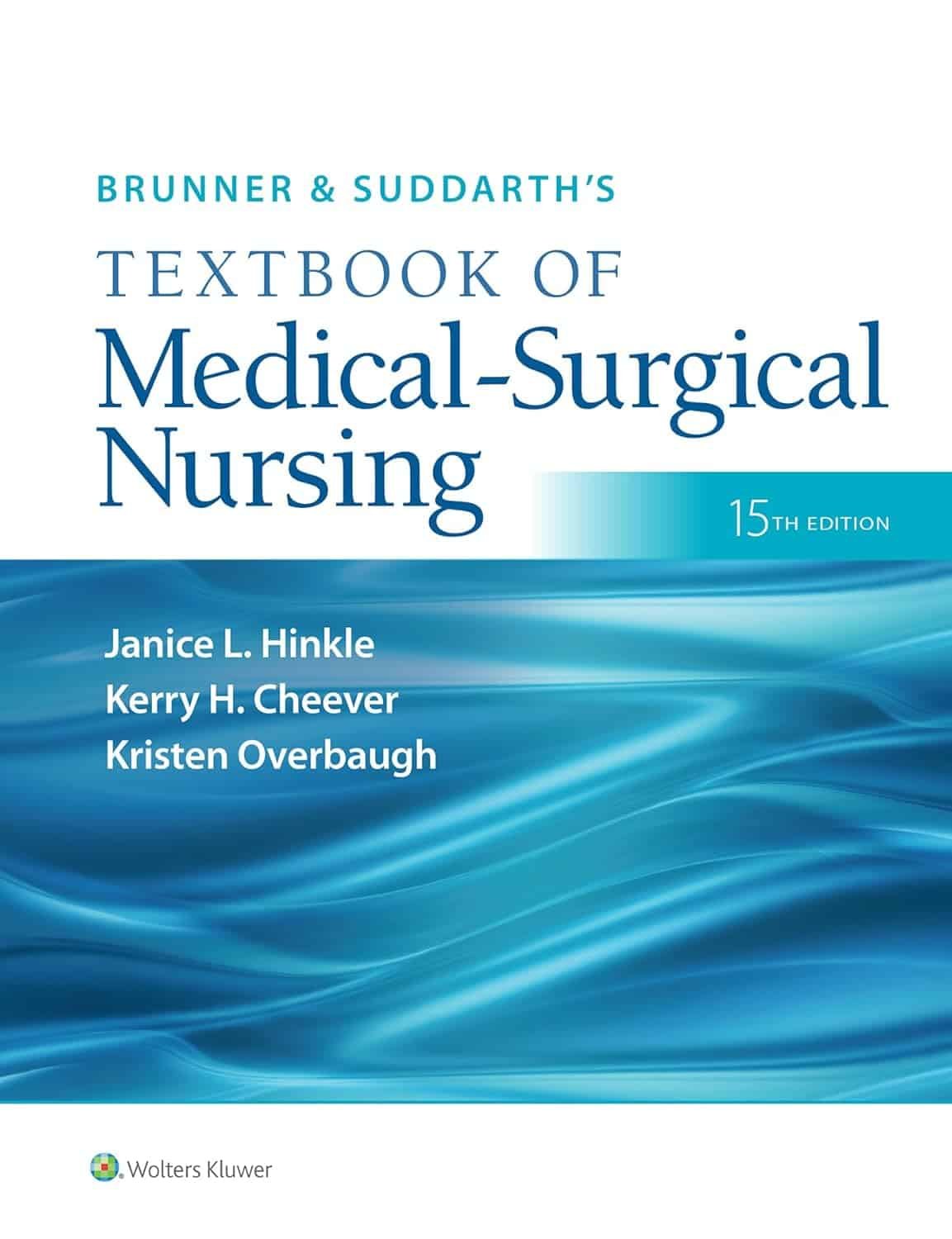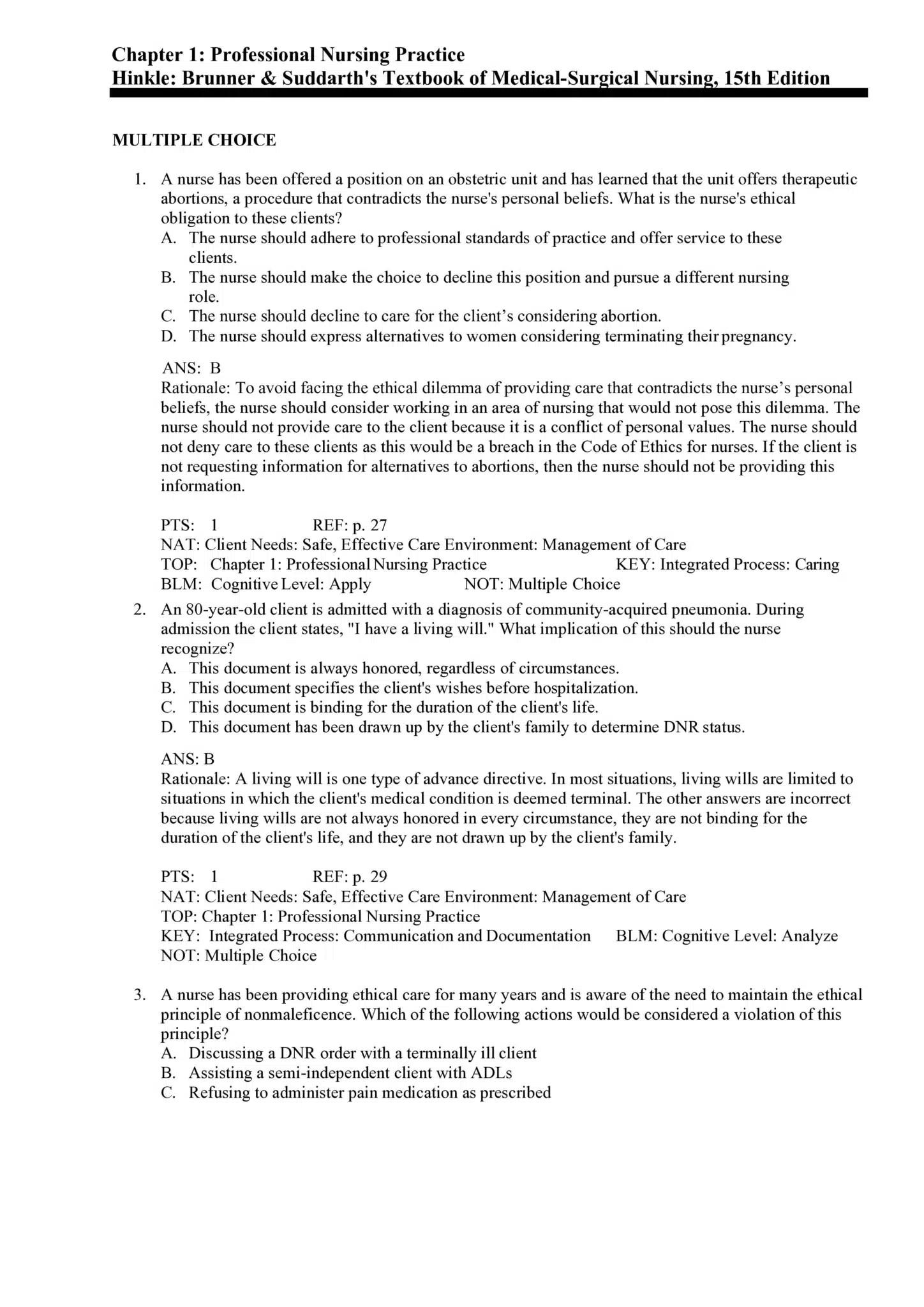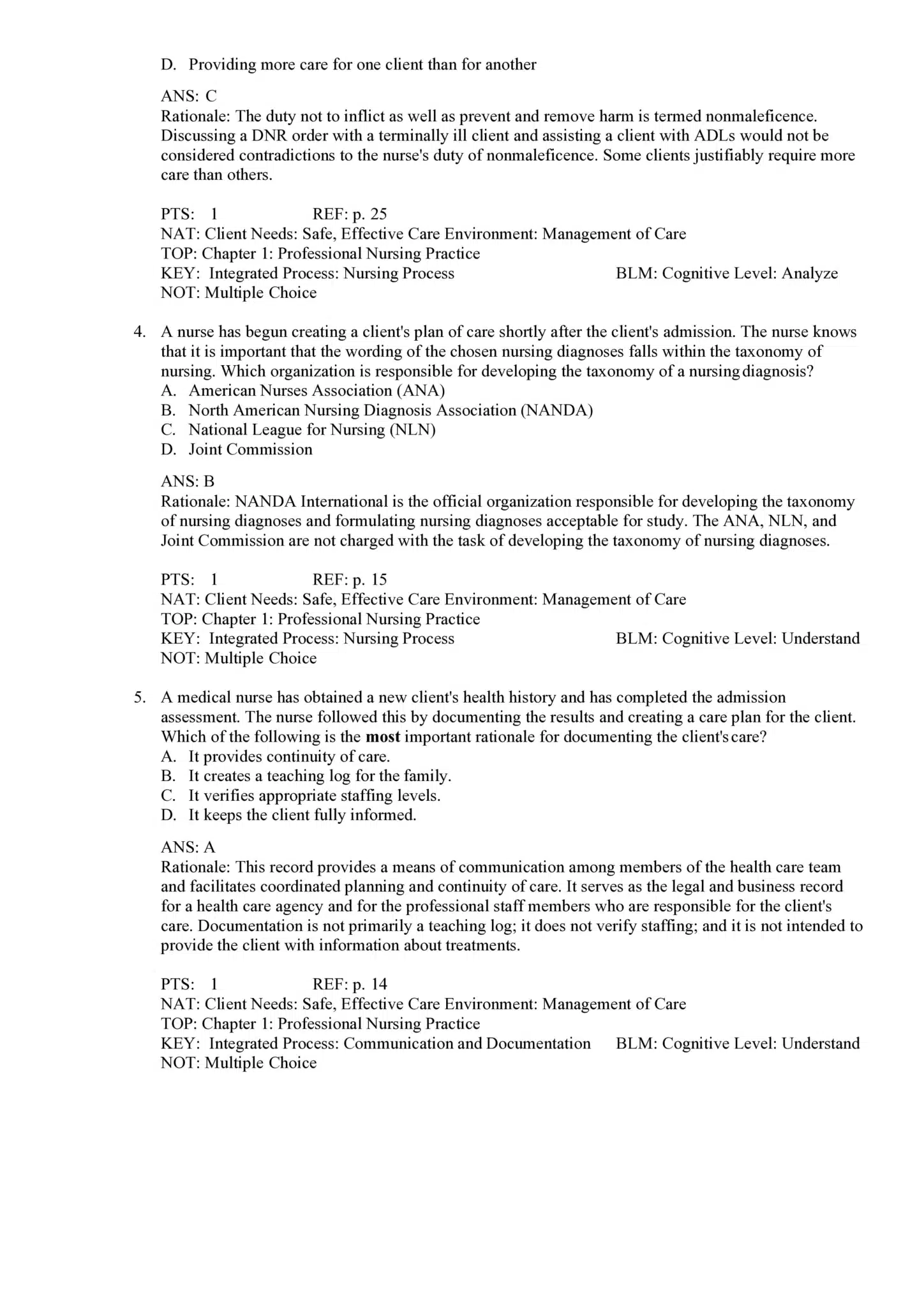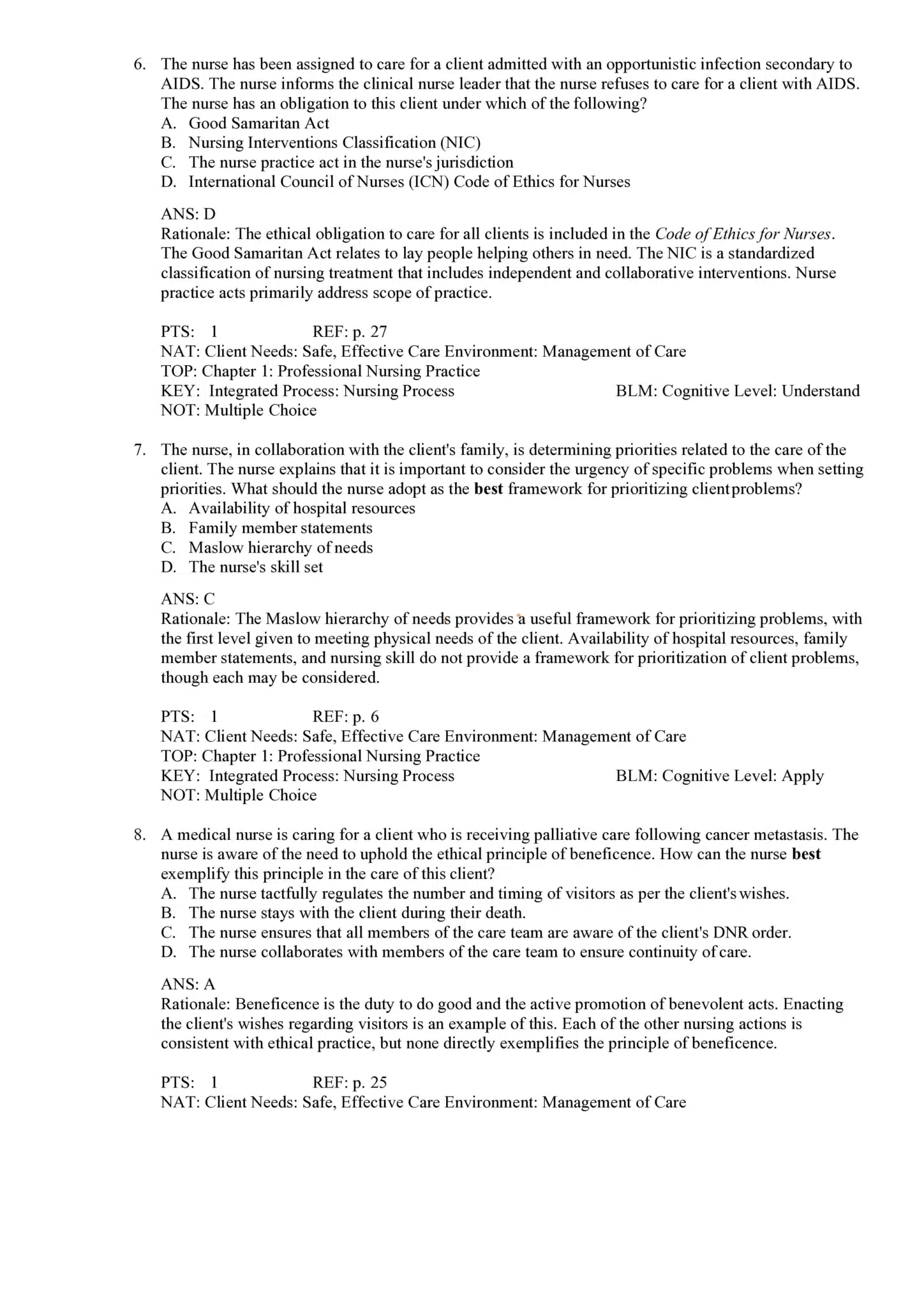Test Bank for Brunner & Suddarth’s Textbook of Medical-Surgical Nursing, 15th Edition by Janice L. Hinkle
$26.00 Original price was: $26.00.$23.00Current price is: $23.00.
Ace your exams with the Brunner & Suddarth’s Textbook of Medical-Surgical Nursing, 15th Edition Test Bank by Janice L. Hinkle. This instant PDF download includes hundreds of NCLEX-style medical-surgical nursing questions with detailed rationales, organized by chapter. Designed to match the 15th Edition textbook, it’s the perfect resource for nursing students preparing for class exams and NCLEX with confidence.

Description
Instant PDF Download – The Brunner & Suddarth’s Textbook of Medical-Surgical Nursing, 15th Edition Test Bank by Janice L. Hinkle is the most trusted resource for nursing students preparing for medical-surgical exams and the NCLEX. It includes hundreds of NCLEX-style questions with detailed rationales to strengthen clinical judgment and exam performance.
Why Choose Brunner & Suddarth’s Med-Surg Test Bank?
- NCLEX-style questions: practice with realistic exam-level items across all medical-surgical topics.
- Organized by chapter: questions align directly with the 15th Edition textbook.
- Detailed rationales: explanations provided for every correct answer.
- Instant access: download the PDF immediately after purchase—study anytime, anywhere.
Chapters Covered in Brunner & Suddarth’s Medical-Surgical Nursing (15th Edition)
- Chapter 1: Professional Nursing Practice
- Chapter 2: Medical-Surgical Nursing
- Chapter 3: Health Education and Health Promotion
- Chapter 4: Adult Health and Physical, Nutritional, and Cultural Assessment
- Chapter 5: Stress and Inflammatory Responses
- Chapter 6: Genetics and Genomics in Nursing
- Chapter 7: Disability and Chronic Illness
- Chapter 8: Management of the Older Adult Patient
- Chapter 9: Pain Management
- Chapter 10: Fluid and Electrolytes
- Chapter 11: Shock, Sepsis, and Multiple Organ Dysfunction Syndrome
- Chapter 12: Management of Patients with Oncologic Disorders
- Chapter 13: Palliative and End-of-Life Care
- Chapter 14: Preoperative Nursing Management
- Chapter 15: Intraoperative Nursing Management
- Chapter 16: Postoperative Nursing Management
- Chapter 17: Assessment of Respiratory Function
- Chapter 18: Management of Patients with Upper Respiratory Tract Disorders
- Chapter 19: Management of Patients with Chest and Lower Respiratory Tract Disorders
- Chapter 20: Management of Patients with Chronic Pulmonary Disease
- Chapter 21: Assessment of Cardiovascular Function
- Chapter 22: Management of Patients with Arrhythmias and Conduction Problems
- Chapter 23: Management of Patients with Coronary Vascular Disorders
- Chapter 24: Management of Patients with Structural, Infectious, and Inflammatory Cardiac Disorders
- Chapter 25: Management of Patients with Complications from Heart Disease
- Chapter 26: Assessment and Management of Patients with Vascular Disorders and Peripheral Circulation Problems
- Chapter 27: Assessment and Management of Patients with Hypertension
- Chapter 28: Assessment of Hematologic Function and Treatment Modalities
- Chapter 29: Management of Patients with Nonmalignant Hematologic Disorders
- Chapter 30: Management of Patients with Hematologic Neoplasms
- Chapter 31: Assessment of Immune Function
- Chapter 32: Management of Patients with Immune Deficiency Disorders
- Chapter 33: Management of Patients with Allergic Disorders
- Chapter 34: Management of Patients with Inflammatory Rheumatic Disorders
- Chapter 35: Assessment of Musculoskeletal Function
- Chapter 36: Management of Patients with Musculoskeletal Disorders
- Chapter 37: Management of Patients with Musculoskeletal Trauma
- Chapter 38: Assessment of Digestive and Gastrointestinal Function
- Chapter 39: Management of Patients with Oral and Esophageal Disorders
- Chapter 40: Management of Patients with Gastric and Duodenal Disorders
- Chapter 41: Management of Patients with Intestinal and Rectal Disorders
- Chapter 42: Management of Patients with Obesity
- Chapter 43: Management of Patients with Hepatic Disorders
- Chapter 44: Management of Patients with Biliary Disorders
- Chapter 45: Management of Patients with Endocrine Disorders
- Chapter 46: Management of Patients with Diabetes
- Chapter 47: Assessment of Kidney and Urinary Function
- Chapter 48: Management of Patients with Kidney Disorders
- Chapter 49: Management of Patients with Urinary Disorders
- Chapter 50: Assessment and Management of Patients with Female Physiologic Processes
- Chapter 51: Management of Patients with Female Reproductive Disorders
- Chapter 52: Assessment and Management of Patients with Breast Disorders
- Chapter 53: Assessment and Management of Patients with Male Reproductive Disorders
- Chapter 54: Assessment and Management of Patients Who Are LGBTQ
- Chapter 55: Assessment of Integumentary Function
- Chapter 56: Management of Patients with Dermatologic Disorders
- Chapter 57: Management of Patients with Burn Injury
- Chapter 58: Assessment and Management of Patients with Eye and Vision Disorders
- Chapter 59: Assessment and Management of Patients with Hearing and Balance Disorders
- Chapter 60: Assessment of Neurologic Function
- Chapter 61: Management of Patients With Neurologic Dysfunction
- Chapter 62: Management of Patients With Cerebrovascular Disorders
- Chapter 63: Management of Patients with Neurologic Trauma
- Chapter 64: Management of Patients with Neurologic Infections, Autoimmune Disorders, and Neuropathies
- Chapter 65: Management of Patients with Oncologic or Degenerative Neurologic Disorders
- Chapter 66: Management of Patients with Infectious Diseases
- Chapter 67: Emergency Nursing
- Chapter 68: Disaster Nursing
Sample Questions from Brunner & Suddarth’s Test Bank (15th Edition)
1. A nurse has been offered a position on an obstetric unit and has learned that the unit offers therapeutic abortions, a procedure that contradicts the nurse’s personal beliefs. What is the nurse’s ethical obligation to these clients?
A. The nurse should adhere to professional standards of practice and offer service to these clients.
B. The nurse should make the choice to decline this position and pursue a different nursing role.
C. The nurse should decline to care for the client’s considering abortion.
D. The nurse should express alternatives to women considering terminating their pregnancy.
ANS: B
Rationale: To avoid facing the ethical dilemma of providing care that contradicts the nurse’s personal beliefs, the nurse should consider working in an area of nursing that would not pose this dilemma. The nurse should not provide care to the client because it is a conflict of personal values. The nurse should not deny care to these clients as this would be a breach in the Code of Ethics for nurses. If the client is
not requesting information for alternatives to abortions, then the nurse should not be providing this information.
PTS: 1 REF: p. 27
NAT: Client Needs: Safe, Effective Care Environment: Management of Care
TOP: Chapter 1: Professional Nursing Practice KEY: Integrated Process: Caring
BLM: Cognitive Level: Apply NOT: Multiple Choice
2. An 80-year-old client is admitted with a diagnosis of community-acquired pneumonia. During admission the client states, “I have a living will.” What implication of this should the nurse recognize?
A. This document is always honored, regardless of circumstances.
B. This document specifies the client’s wishes before hospitalization.
C. This document is binding for the duration of the client’s life.
D. This document has been drawn up by the client’s family to determine DNR status.
ANS: B
Rationale: A living will is one type of advance directive. In most situations, living wills are limited to situations in which the client’s medical condition is deemed terminal. The other answers are incorrect because living wills are not always honored in every circumstance, they are not binding for the duration of the client’s life, and they are not drawn up by the client’s family.
PTS: 1 REF: p. 29
NAT: Client Needs: Safe, Effective Care Environment: Management of Care
TOP: Chapter 1: Professional Nursing Practice
KEY: Integrated Process: Communication and Documentation BLM: Cognitive Level: Analyze
NOT: Multiple Choice
3. A nurse has been providing ethical care for many years and is aware of the need to maintain the ethical principle of nonmaleficence. Which of the following actions would be considered a violation of this principle?
A. Discussing a DNR order with a terminally ill client
B. Assisting a semi-independent client with ADLs
C. Refusing to administer pain medication as prescribed
D. Providing more care for one client than for another
ANS: C
Rationale: The duty not to inflict as well as prevent and remove harm is termed nonmaleficence. Discussing a DNR order with a terminally ill client and assisting a client with ADLs would not be considered contradictions to the nurse’s duty of nonmaleficence. Some clients justifiably require more care than others.
PTS: 1 REF: p. 25
NAT: Client Needs: Safe, Effective Care Environment: Management of Care
TOP: Chapter 1: Professional Nursing Practice
KEY: Integrated Process: Nursing Process BLM: Cognitive Level: Analyze
NOT: Multiple Choice
4. A nurse has begun creating a client’s plan of care shortly after the client’s admission. The nurse knows that it is important that the wording of the chosen nursing diagnoses falls within the taxonomy of nursing. Which organization is responsible for developing the taxonomy of a nursing diagnosis?
A. American Nurses Association (ANA)
B. North American Nursing Diagnosis Association (NANDA)
C. National League for Nursing (NLN)
D. Joint Commission
ANS: B
Rationale: NANDA International is the official organization responsible for developing the taxonomy of nursing diagnoses and formulating nursing diagnoses acceptable for study. The ANA, NLN, and Joint Commission are not charged with the task of developing the taxonomy of nursing diagnoses.
Frequently Asked Questions
What is included in the Brunner & Suddarth’s 15th Edition Test Bank?
It includes hundreds of exam-style, NCLEX-format questions across all chapters, with detailed answer rationales.
Is this test bank good for NCLEX preparation?
Yes. Items mirror NCLEX style and med-surg exam difficulty, helping you build clinical judgment and test-taking skills.
Who authored the textbook this test bank supports?
This test bank accompanies Brunner & Suddarth’s Textbook of Medical-Surgical Nursing, 15th Edition by Janice L. Hinkle.
How do I access the file after purchase?
You’ll receive instant digital access to the PDF after checkout—no shipping required, study immediately on any device.
Do the questions include answers and rationales?
Yes. Every question includes the correct answer with an evidence-based rationale to reinforce learning.
Instant Digital Download
Study anywhere, anytime. The Brunner & Suddarth’s Medical-Surgical Nursing 15th Edition Test Bank is delivered as a secure PDF, compatible with computers, tablets, and smartphones. Download instantly and start preparing today.
More Resources
Only logged in customers who have purchased this product may leave a review.
Related products
-
Sale!

Wong’s Nursing Care of Infants and Children 12th Edition Test Bank PDF
$26.00Original price was: $26.00.$23.00Current price is: $23.00. Add to cart -

Test Bank for Mental Health Nursing (6th Edition) — PDF with Answers & Rationales
$23.00 Add to cart -
Sale!

Test Bank for Huether & McCance’s Understanding Pathophysiology, 2nd Canadian Edition
$26.00Original price was: $26.00.$23.00Current price is: $23.00. Add to cart -

Test bank for Davis Advantage for Townsend’s Essentials of Psychiatric Mental Health Nursing 9th Edition
$23.00 Add to cart





Reviews
There are no reviews yet.